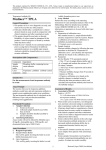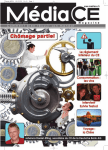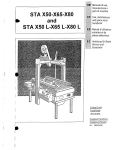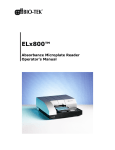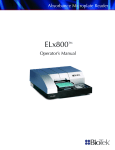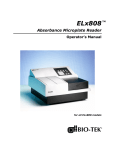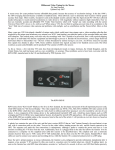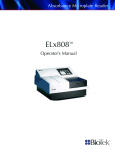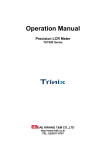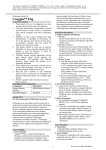Download Internal Information Sheet
Transcript
This product marketed by SEKISUI MEDICAL CO., LTD., Tokyo, Japan is manufactured subject to our supervision as stipulated in the Pharmaceutical Affairs Law of Japan and is allowed to be sold in Japan. For details, please contact us or your local distributors. Non-Treponemal Lipid Antibody Kit Mediace™ RPR (A)(M) General Precautions 1. This product is for in vitro diagnostic use only, and must not be used for any other purposes. 2. Clinicians should make a comprehensive clinical decision based on assay results in conjunction with clinical symptoms and other examination results. 3. This product should be used only as directed. Reliability of values cannot be guaranteed if this product is used for purposes or tested by methods other than those stated. 4. Read the user’s manual of your automated analyzer prior to using this kit. Parameters for different automated analyzers are available upon request. Analyzers should be cleaned before use to ensure accurate calibration. 5. RPR Standard Serum contains human derived material. Handle carefully as if potentially infectious. 2. 2) Collected sample should be used while they are fresh. 3) Handle the samples carefully to prevent infection. Interfering Substances Assay results will not be affected by bilirubin (up to free type 19.7 mg/dL, conjugate 21.0 mg/dL), hemoglobin (up to 488 mg/dL), RF (up to 450 IU/mL), or heparin (up to 30 IU/mL). Assay Procedure 1. Reagent Preparation 1) Sample Dilution Buffer Mix well by gently inverting the bottle to avoid bubble formation prior to use. 2) Latex Suspension Mix well by gently inverting the bottle to avoid bubble formation prior to use. 3) Standard Syphilis Positive Serum Mix well by gently inverting the bottle to avoid bubble formation prior to use. 2. Assay Method Perform the assay according to the operating instructions for the automated analyzer. Refer to the Method Sheet for the detailed assay method. Contact SEKISUI MEDICAL CO., LTD. for information on parameters to be used with other types of analyzers. 1) Preparation of the calibration curve Mix the standard syphilis positive serum, sample dilution buffer and latex suspension to start the reaction. Prepare a calibration curve based on the difference in turbidities measured at predetermined times. 2) Sample Analysis Measure turbidity changes by following the same procedure as described in 1), and measure the anti-lipid antibody titer in the sample based on the calibration curve. 3) Parameters (for the Hitachi 7170 automated analyzer) 1. Mix 180µL of buffer and 20µL of sample and incubate the mixture at 37°C for about 5 minutes. 2. Add 60µL of the latex suspension and incubate the mixture at 37°C. 3. Measure turbidity changes from 50 seconds to 4 minutes after adding the latex suspension at a wavelength of 700 nm. 4. Prepare a calibration curve based on the turbidity changes in each reference solution following the same procedure as above, and measure the anti-lipid antibody titer based on the turbidity changes. Description (Kit Components) Component Ingredients Sample dilution Phosphate buffer buffer containing bovine serum albumin Latex suspension Latex coated with lipid antigens (cardiolipin and lecithin) (Sold Separately) RPR positive human RPR Standard serum Serum (5 concentrations)* *Contains human-derived serum. Details given in "Handling Precautions." Intended Use For the measurement of syphilis anti-lipid antibody in serum or plasma Assay Principle The reaction between the polystyrene latex, sensitized with lipid antigens (cardiolipin and lecithin) and the sample under given conditions results in the agglutination of latex and syphilis anti-lipid antibody contained in the sample. The syphilis anti-lipid antibody titer in the sample is measured based on the difference in pre- and post-reaction turbidities (turbidity changes), or the post-reaction increase in turbidity, resulting from the agglutination. Procedural Precautions 1. Sample Collection 1) Samples Serum and plasma can be used. Assessment of Results 1. Assessment of Results Positive: >1R.U. 1 Revised: (December) 2011 (3rd edition) This product marketed by SEKISUI MEDICAL CO., LTD., Tokyo, Japan is manufactured subject to our supervision as stipulated in the Pharmaceutical Affairs Law of Japan and is allowed to be sold in Japan. For details, please contact us or your local distributors. 2. 3. 4. 5. 6. 7. (*2) R.U. (RPR Units) is based on the WHO Standard. 1 R.U. is equal to 0.4 IU. 1 R.U. is equivalent to the value using the RPR card method. When results come out positive using this kit, run subsequent tests and make a decision taking in consideration other examination results and clinical symptoms. Clinicians should make a comprehensive clinical decision based on assay results in conjunction with clinical symptoms and other examination results. Do not make a diagnosis based on results obtained from this kit alone. Serum samples from patients in the early stage of antibody production or with decreased antibody production due to compromised immune function contain a small amount of antibody and may test negative. A non-specific immune response may occur in serum samples from patients with autoimmune diseases. Serum samples from patients receiving blood products containing immunoglobulins may test positive. Evaluate results carefully. Keep in mind that the prozone phenomenon (which is associated with immune response) may affect results. 1. Handling Precautions 1) All samples used in the test should be handled as if potentially infectious for HIV, HBV and HCV. Human materials used in formulating RPR Standard Serum has been tested and found to be negative for HIV antibody, HBV antigen, and HVC antibody. However, handle as if potentially infectious. To prevent the risk of infection, use disposable gloves and avoid mouth pipetting during the test. 2) Do not eat, smoke, apply cosmetics or touch contact lenses in the testing area where samples and reagents are handled. 3) Buffer, latex suspension, and RPR Standard Serum contain sodium azide at a concentration 0.1% or lower as a preservative. If the reagent accidently comes into contact with the eyes or skin, immediately and thoroughly rinse the affected area with water and seek medical treatment if necessary. 4) To prevent infections from spilled samples or sample-contained solutions, wipe the spill area thoroughly with sodium hypochlorite solutions at concentration greater than 0.1%. 2. Precautions for Use 1) Store according to the storage instructions. Avoid freezing. Do not use this product if it has been frozen, stored under conditions other than those specified, or has expired. 2) Do not combine or mix sample dilution buffer and latex suspension from different lots. 3) Prepare a calibration curve for every assay. Do not change the bottle of sample dilution buffer or latex suspension with other bottles or use reagents from other lots during the assay. 4) Use the thermostat of the analyzer to ensure that the reaction temperature is evenly distributed. 5) Check the reagent bottle and its label before using this product. Do not use the reagent if the label has been peeled off or if the label is smudged or illegible. 3. Precautions for Disposal 1) Sterilize or disinfect any waste arising from the assay in the same way as for the samples and reagents. When disposing waste material, follow the applicable laws at your location. 2) When disposing used containers, treat them as medical or industrial waste or the like and abide by relevant regulations on waste. 3) Sodium azide contained in the reagents may react with lead or steel pipes and produce highly explosive metallic azide. When washing off reagents from the skin or if reagents have been accidentally discarded into the sewage system, take appropriate measures (e.g., flush them down the drain with a large amount of water). Performance 1. Performance The performance when used in accordance with the standard testing method is described below. 1) Sensitivity The turbidity change (ΔAbs) per 1 R.U. of syphilis anti-lipid antibody: ≥ 0.0100 2) Specificity 80-120% of expected assay value 3) Within-run Reproducibility Coefficient of variation 15% (Assays of 10 replicates for each of 2 types of control sera with different antilipid antibody titer for syphilis) 4) Measurement Range 0.2-8 R.U.2) (on the Hitachi7170 automated analyzer) For samples with antibody titers exceeding 8 R.U., dilute with physiological saline before conducting the assay. 2. Correlation 1) Serum 1) 2) N= 82 r = 0.909 y = 1.008x + 0.345 Reference method: RPR card test method (MHLW approved IVD) 2) Plasma 2) N=88 r = 0.995 y=1.03x+0.05 Reference method: comparison with serum samples collected simultaneously using this method Storage and Shelf Life 1. Storage: Store at 2 to 8°C (avoiding freezing) 2. Expiration: 6 months (indicated on the outer box and the container) Precautions and Warnings 2 Revised: (December) 2011 (3rd edition) This product marketed by SEKISUI MEDICAL CO., LTD., Tokyo, Japan is manufactured subject to our supervision as stipulated in the Pharmaceutical Affairs Law of Japan and is allowed to be sold in Japan. For details, please contact us or your local distributors. Package Content 1. Mediace™ RPR (A) Description Buffer Solution Latex Suspension Configuration 18 mL x 2 12 mL x 1 2. Mediace™ RPR (M) Description Buffer Solution Latex Suspension Configuration 60 mL x 1 20 mL x 1 3. Sold Separately Description RPR Standard Serum (5 concentrations) Configuration 1mL x 5 concentrations References 1) Kazuhisa Osato et al. Clinical Evaluation of Reagents for Latex Agglutination Test for Anticardiolipin Antibody and Anti-TP Antibody; Journal of Japanese Society for Sexually Transmitted Diseases 13; 124-130, 2002 2) SEKISUI MEDICAL CO., LTD. In-house data Marketing Authorization Holder SEKISUI MEDICAL CO.,LTD. 13-5, Nihonbashi 3-chome, Chuo-ku, Tokyo, Japan [email protected] "Mediace" is a trademark owned by SEKISUI MEDICAL CO.,LTD. JAPAN, and is registered in Japan and/or other countries. 3 Revised: (December) 2011 (3rd edition)



